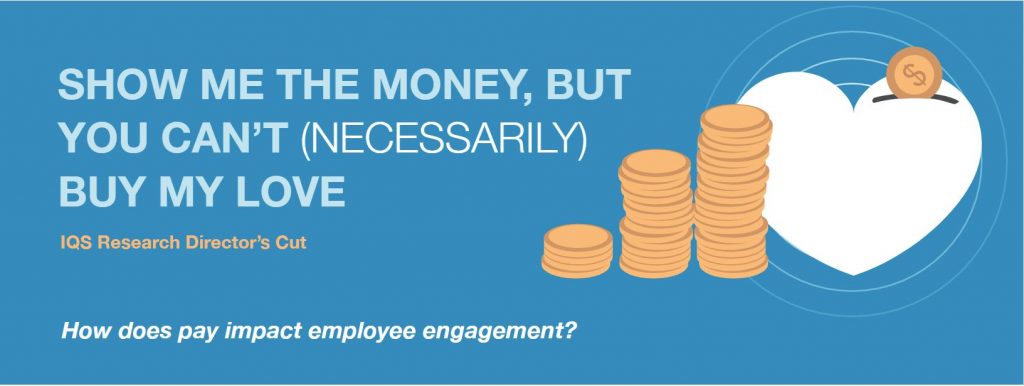
Most management literature says that pay is not a factor in engagement and, very often, raising pay to increase engagement will only have a minimal or short-term impact. However, few of us are working for free, and none of us would voluntarily reduce our pay. When the IQS Research team analyzed data from hundreds of studies and thousands of employees, we find that pay does matter up to 36% of the time. So, ho should we think about this complex and nuanced topic?
There are three primary ways that pay interacts with engagement.
1. If the pay score is below 20%, there is a problem.

Using our measurement process, when the score for pay is below 20%, we typically find the cause to be a market-based pay differential. In these situations, the competitors are paying significantly more, and the employees are aware of this difference. These employees will be less engaged and are also more likely to leave. Even if employees don’t seek out opportunities to leave, they are very open to opportunities that come their way. In this case, raising pay to be competitive with the marketplace will generally increase employee engagement for that departments and also reduce turnover. The chart to the left shows how paying below the market rate usually drives down your engagement score. The trend levels out once marketplace parity is achieved.
2. When working conditions change, pay satisfaction scored can decline.
When an employee originally accepts a position, part of the assessment is an internal cost/benefit analysis. The employee has an expectation of what working in that job will be like and decides whether it matches the offered compensation. If those working conditions change (manager, hours, responsibilities, expectations), the employee may feel that the compensation is no longer in line with his/her new reality. In these cases, increasing pay will provide, at best, a temporary fix, and it is better to address the underlying issues. In cases where the change in working conditions is temporary, such as a transitional period or peak times, consider other ways to acknowledge employee efforts. Long-term or systemic issues may require a greater investment of time and energy, or even a realignment of personnel.
3. Acceptable pay scores vary by department and position.
Assuming pay satisfaction is above 20%, and there have been no major changes in working conditions, what constitutes a “good” score? Well, it depends. An acceptable pay score for a retail cashier would be low if given by a commissioned salesperson. Pay satisfaction scores vary by position and department type. We have found that pay scores can be grouped into five general buckets for hourly, salary, leadership, commissioned personnel, and specialized administrative.

When scores are below these thresholds, raising pay will increase engagement and might seem to be the obvious answer. However, it may not be the only answer. You should also consider the role of leadership, team, and work environment. All of these have an impact on employee engagement and will be the topics of our next Director’s Cuts.
Considering an Employee Engagement study for your company?
The business case for employee engagement is salient—and IQS Research is here to help.
While many research companies offer a one-size-fits-all approach to assessing employee engagement, our data collection process is tailored to meet your organization’s needs. Drawing from a portfolio of validated questions and applying cutting-edge methodologies, we gather candid feedback to provide actionable insights so that your organization can own your tomorrow.
Contact us today!
IQS Research
308 North Evergreen Road
Suite 200
Louisville, Kentucky, USA 40243
Telephone: +1 (502) 244-6600
Email: ask@iqsresearch.com




